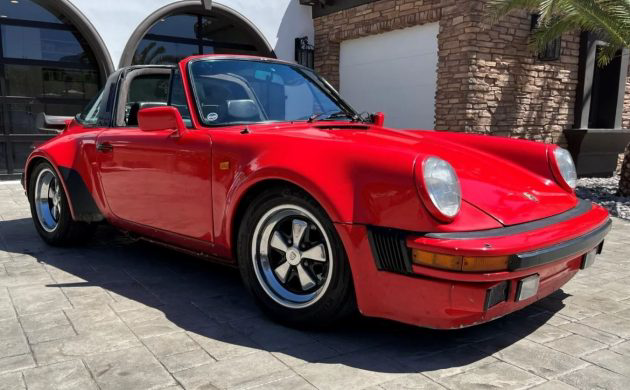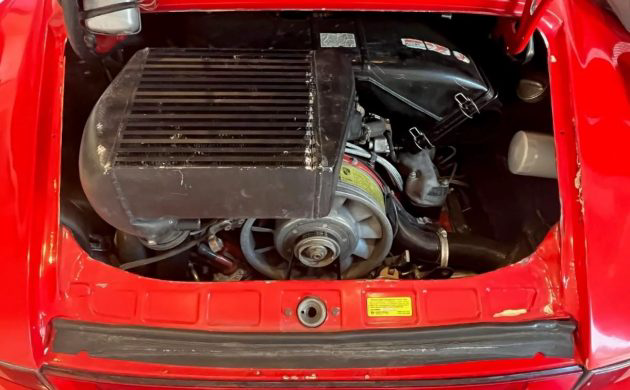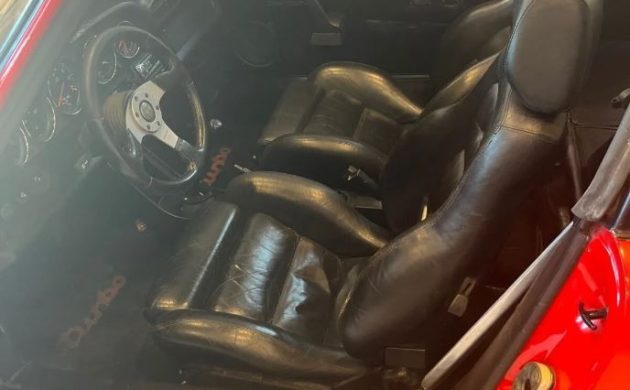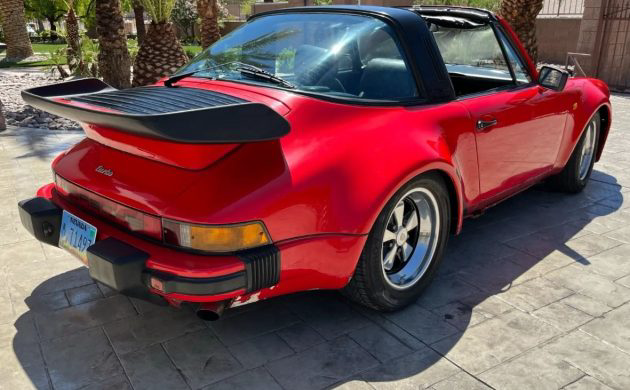
Claiming unique status for any classic car is a bold move. However, possessing supporting evidence transforms a bold claim into an indisputable fact. Such is the case with this 1978 Porsche 930 Turbo. It has a colored history, but factory paperwork and other documentation held by the seller confirm it is the only Targa example produced during that model year. If that isn’t enough to whet your appetite, this car also predates the production run of regular 930 Targas by several years. Its next journey could be to a new home with a discerning collector. The seller has listed the 930 Turbo here on eBay in Las Vegas, Nevada. Unsurprisingly, for a classic in this price range, it hasn’t received any bids. The seller set their auction to open at $789,300 but provides a BIN option of a cool $1,000,000 for those wishing to throw caution to the wind.

The history of this Porsche is long and convoluted, almost deserving its own book to cover its story in-depth. The 930 Turbo joined the Porsche range in 1975 and remained in production until 1989. The company added the Targa variant in 1987, which may lead some readers to question how this 930 can be legitimate. However, the VIN and included factory documentation confirm that this classic rolled off the line in 1987. It seems this was the last of eleven examples built as factory test vehicles and is the only one that survived. It remained the property of Porsche until 1980 before falling into private hands. The panels wear India Red paint, which isn’t the car’s original shade. It underwent a color change during the 1980s, with the paperwork revealing it was initially cloaked in Olive Green. It is unclear why the change occurred, and the car’s history and the accumulated chips and marks may motivate the new owner to return the exterior to its factory form. The panels are pretty straight, with no mention or evidence of rust. The trim and glass are excellent for a survivor-grade classic, with the enormous Fuchs wheels and “whale-tail” rear spoiler adding a sense of purpose.

This Porsche’s history becomes more mysterious when we focus on its drivetrain. The engine bay houses the beautiful US-spec turbocharged 3.3-liter flat-six that sends 251hp and 282 ft/lbs of torque to the road via a four-speed manual transaxle. The 930 Turbo isn’t what I would classify as a “point-and-squirt” classic, although the ¼-mile ET of 14.1 seconds is pretty impressive. However, let off the leash, it will cruise effortlessly at 150mph. Our feature car isn’t numbers-matching, and a fascinating story could be attached to that. The VIN offers the tantalizing prospect that it may have rolled off the line equipped with the same engine as fitted to the twenty-five RSR 935 Group 5 cars. However, Porsche’s documentation states the VIN’s engine designation of “9” was due to the vehicle being a non-production model. It is unclear when or why the engine change occurred, but if the motor was a genuine RSR version, the company may have removed it to tame what would have been a savage beast. The 911 range from this era developed the nickname “The Widowmaker.” They could bite anyone who confused their ambitions with their ability, and some did leave the road backward to join the scenery as a result of this approach. The seller says that finding the original motor may be possible due to the available online resources, but they would probably leave it untouched. I’m afraid I have to disagree because if the documentation supports the claims, returning the entire car to its factory appearance and specifications would cement its long-term investment potential. Interested parties will welcome the fact this 930 runs and drives well. It allows them to enjoy it immediately while planning their path if restoration is on their mind.

The Porsche’s interior is trimmed in Black leather, and its condition is comfortably acceptable if the new owner chooses preservation as their preferred path. The body-hugging bucket seats exhibit minor wear on their outer bolsters, but not to the point where a leather specialist couldn’t bring them back from the edge. The remaining trim and carpet are tidy, and there are no issues with the dash or pad. Swapping the aftermarket wheel for something more appropriate would be easy, but reinstating the factory radio could be more challenging. It appears its rightful spot now houses a CD player, meaning the dash will have been cut to accommodate the change. Otherwise, there are no other modifications requiring attention.

This 1978 Porsche 930 Turbo Targa seems to be a genuinely unique car, and many purists would love to park it in their garage. It is hardly cheap, with the price significantly higher than buyers might expect to pay for a regular production version. However, it raises the question of what price you could place on a classic of this caliber if the claims are verifiable. It will be fascinating to gauge your feedback on that question and whether you would search for the original engine so it can be returned to its factory form. So, over to you.


Impressive find. I have an earlier 911 with a 2.7RS spec motor in it. It is fearsome to unleash it’s power. I don’t have near the power the car listed here has. You’d have to be a very good driver to get everything out of this car that it has.
My dad & I restored the 62 Carrara Lemans Porsche Factory werks car X019 with Dr.Porsche who became personal friends with dad.
Thing about these Factory 1 offs is the Engine is built by 1 porsche master mechanic & that’s how we found our Numbers matching engine with its busted cam lobe, by Dr Porsche himself giving my dad the Factory work order logs
Wildly the retired German Porsche Master had moved overseas to Des Moines Iowa where we lived & owned our Porsche store.
I recall going as a teen to the guys house while he & dad spoke in their rough Bauendeutsche – Farmer German Slang.
Engine was there in a crate – Porsche has a factory policy if the engine fails it goes to its original builder.
So knowing this I’d contact Porsche & obtain the factory build sheets & find the name address etc of original engine builder & run it down.
Having the 935R original factory test mule engine in it & yes believe it or not Porsche will actually on historic models like this one restore the original factory finish.
$$$€£¥€€ Better be ready to spend tho …
I guess we got lucky being able to have Dr Porsche himself run down the info we needed.
Rare car COULD be rarer if restored properly.
I read the magazine article attached to EBAY – there’s NO WAY Porsche installed a u.s. spec 3.3L in that car & if it was indeed a factory test mule it’s obvious to me KONRAD racing took the original 935R engine OUT & installed the civilian version.
Porsche would have no reason to install a u.s. spec engine.
Pretty car but it has a VERY shady history.
Not numbers matching the CHASSIS is rare but without that special 935R engine it’s worth maybe 60k
NOT 1mil
Guy is selling HYPE
Given the story, and the pricing, I think the seller is just using Ebay as a means of advertising the existence and availability of the car.
I agree with folks that say, why sell this on eBay? If I owned this car, I would put it at Amelia Island, and if he tried and the auction houses said, nawww, well, that’s salient information.
While this looks like a sharp Targa, the claims sound too far-fetched to me, especially given the car has that Pep Boys steering wheel. If this really was a one-of-a-kind car, EVERYTHING would be what it would have coming out of Stuttgart in 1978. Details!
Hi everyone, I’m the owner of this Unicorn 930. Thank you Barn Finds for picking up on the fact that I have this for sale and writing your article! I’m not on social media of any sort, so I learned about this through a friend of mine who is 2,500 miles away from me, but knows I own this car.
-First factory Turbo Targa released to the public.
-1 of 1 for 1978 – No Turbo Targa’s were built until 1987.
-First Open Air 930.
-Porsche Owned
-Olive Green (Ferry Porsche primarily had green cars)
-Published in December 1994 Excellence Magazine
For anyone who doesn’t know what 930 represents, it’s a factory turbocharged Porsche 911. It only came in a coupe from 1975 to 1987, with the exception of this car that was built as a “Targa”, which is what they called the removable top.
It’s the real deal, fully documented from Porsche. Extensive history from a bunch of people who which they still owned this car. Back in the 80’s and 90’s it was special, but nobody would have ever predicted what has happened to the air-cooled market over the past 15 years and the collectability of all air-cooled Porsches, particularly the 930.
The car was built in September of 1977, not 1987 as stated in the article above. Having #1 from 1987 on that run of 930 Targa’s would be significant as well and a hell of a barn find, but this car was actually built an entire decade before those, which is a very important distinction.
There are general rules when it comes to collecting and value, which some people don’t seem to understand. They are centered around desirability and how many of whatever is being collected are in existence. If you can count how many exist on one hand, then you have something extremely special if its something that is desirable in this world of 8 billion people. In this case you can count on one finger how many of this same car exist in the world. It’s the first Porsche 930 Targa that left the factory a full decade before they produced them in 1987. This is as good as it gets in terms of hierarchy of models for Porsche that were meant for everyday driving in the 70’s. I would argue that turbo technology and the introduction of the 930 as a car for the typical consumer is why Porsche is the company it’s become and why the air-cooled cars are so valuable. For those of you who don’t know, Porsche’s growth was rooted in racing. To compete in certain racing series, they had to sell a certain amount of those race cars to the public as street legal cars. In 1975 400 units was the magic number, so there were exactly 400 1975 Porsche 930 coupes built, so they could put the turbo technology on the track and dominate the racing series, which they did. In 1978 Porsche faced the same requirements for a different series of racing and had to produce and sell 25 Group 5 production race cars (aka Moby-Dick) to the public to qualify for the series, which they did. These don’t trade very often, but when they do there’s a line of Porsche collectors willing to pay millions of dollars for the right to own such a rare car.
Prior to producing the 911, Porsche built the 356, which is also a very desirable and collectable car. There was a convertible version of that model and a stripped down version of the convertible known as the Speedster, which are also extremely valuable cars. Most people know this car, even if you are not a car person. When they stopped building the 356, they started building the 911 coupe, but Porsche customers who loved the 356 convertibles were demanding an open air option for the 911. As great of engineers as they were, they couldn’t marry the increased horse power of the 911 to a flimsy convertible chassis without some added rigidity to prevent twisting of the chassis. The solution was the Targa, which is known for it’s roll bar just behind the doors to add rigidity to the chassis. Introduce the turbo engine and you have a similar issue with the rigidity of the Targa chassis.
The point of the readers digest version of the history is to establish the basis for the significance of this particular car. This was the 11th attempt to marry the power of a 930 with the customer demand an open air road car. Utopia for the Porsche customer. A purposeful collision of the joy of the 356 convertible with the power of the turbo. Great intensions, but something happened that prevented the production of this marriage until 1987 when Porsche introduced the Turbo Targa and Turbo Convertible to the world. The first 10 chassis were destroyed after testing and nothing was built after #11. Somehow #11 made it out of the factory, out of Porsche’s possession in the early 80’s and into my garage 45 years after coming off the assembly line.
The comment that it’s a non-matching numbers car isn’t totally accurate or fair. This part of the history that is most interesting to me. Porsche removed what they say was a standard 3.3 Liter US Version engine and transmission prior to selling this car to the public. The 3.3 liter turbo engine was introduced with the 1978 coupes and was tested prior to production of the coupes. I have documentation that states that the mileage on this car was 159 miles when arriving to the US in 1984, 7 years after its production date. I have a 1979 911 SC Euro (grey market) car and the speedometer change was documented as part of the importing process to the US. With this 930 Targa, there is no such documentation. One could assume that it was built with the US version of the speedometer (MPH), since it’s documented that it had a US 3.3 Liter Engine. That would seem logical to most people. If the speedometer wasn’t changed prior to importing to US, then only 159 miles were put on this car in the 7 years prior to being shipped to the US. Hardly enough miles to do any real testing for the engine or the chassis. The Vin # has a 9 in the position that identifies the engine type. The 9 is only present in the 25 Moby-Dick race cars mentioned above that were built at this same time. There should have been an 8 in that position, which would represent US 3.3 Liter Turbo Engine. Japan version of the same had a 7 in this position. Porsche explained this as 9 was used because this was a non-production car although the Moby-Dick cars were technically considered production cars to qualify for the racing series.
Makes one wonder and question a lot of things about this car, which is why its so great and interesting.
Was this Ferry’s test toy? The uniqueness and the color certainly point in that direction.
Was this some sort of test to marry a version of a racing motor to a Targa chassis?
Someone out there knows the entire history and why it exists, but I don’t have those connections. I’ve heard many different stories, which any of them could be true.
No reason for anyone to hate this car or me for trying to sell it. I think it’s the most interesting car in the world because it’s uniqueness, rarity, and mystery for a brand that we all love.
I’m a successful Architect who has been infatuated with Porsche my entire life. I have owned over 30 Porsches in the past 30 years and plan on keeping a half dozen classics for me to enjoy for the rest of my life and pass those down to my kids. This would be the holy grail of most collections and I feel very fortunate to have cross paths with this car. Truth is that I have a very time consuming career and a young family that takes priority of all my time. This car deserves someone will preserve it and put the time and effort into it to preserve it’s greatness.
BTW – I’m selling on eBay because it the only accessible market place for me that allows the reserve to be what it needs to be in this case. Taking sales advice from people who have no skin in the game isn’t something that I’m willing to accept. No Reserve or very limited reserve that is generated by previous sales for a car that has no comps and more non-believers than believers is a very dangerous scenario. This is the unicorn and there isn’t another one out there. If you want it, you can buy it, but you have to pay what I’m asking. There isn’t a second choice out there in this case. Thanks!
I have a 1 of 1 Chevy. It’s the only one owned by me.
It’s gonna take a few chips to pry it from my hands but I will consider trades.
This thing is just slightly less ugly than the Lancer above. It looks like a Hot Wheels toy.
But what about the 89,000 miles?